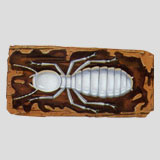Termite Swarmers Are Baaack!
By Chris Williams on March 27, 2013.
 In this blog space just a year ago we reported that pest control companies had been noticing fewer subterranean termite swarms in the last few years. When swarms did occur, they were much smaller in size. In the Northeast, the usual springtime panic phone calls were way down. For most people, the sight of termite swarmers is the first indication that they may have a termite problem. Winged termite swarmers usually appear in the spring and for only a short time. Experts say that the lack of swarmers doesn’t mean fewer termites, it just means that termite behavior has been affected for some reason. Weather, of course, was most often blamed for the change in termite habits.
In this blog space just a year ago we reported that pest control companies had been noticing fewer subterranean termite swarms in the last few years. When swarms did occur, they were much smaller in size. In the Northeast, the usual springtime panic phone calls were way down. For most people, the sight of termite swarmers is the first indication that they may have a termite problem. Winged termite swarmers usually appear in the spring and for only a short time. Experts say that the lack of swarmers doesn’t mean fewer termites, it just means that termite behavior has been affected for some reason. Weather, of course, was most often blamed for the change in termite habits.
Whether it’s good news or bad news, the latest industry talk now is that termite swarms seem to be back. It’s like the good old days again. The only reason that the reappearance of termite swarms would be good news is that it’s often swarms that alert us to the fact that termites may be infesting a structure. Termite damage is usually hidden and can continue unseen for a long time, but the sight of hundreds or thousands of winged termites taking flight or bumbling around inside your home can’t be so easily overlooked.
Termite swarming is triggered by a combination of heat, light, and moisture. For most termite species, swarming occurs on a warm spring day, usually after rain. Outdoors, swarmers emerge directly out of the ground or from infested wood. Indoors, they emerge from mud swarming tubes (which may be hidden inside walls), or from any tiny opening that they can find.
The purpose of winged reproductive termites, or swarmers, is to mate and start new termite colonies. The bad news is that when you see termite swarmers you know you’re dealing with a mature colony that has been developing for a number of years. The number of swarmers that appear is proportional to the size and age of the termite colony. Really big swarms don’t occur until the colony has been in business for 8 to 10 years.
Seeing swarming termites outdoors is usually not cause for concern. Termites are everywhere outside. Swarms could come from a buried tree stump, old railroad ties, or a fallen tree limb. Termites can be nesting anyplace that wood is in contact with soil. But swarming termites indoors is not something you should ignore. Indoors, winged termites are attracted to light and often end up around windows. The winged termites around the inside of your patio door could have come from anywhere in your house – from just across the room, out of a heat register, or from a hall closet upstairs. If you’re only finding a couple of swarmers inside, it’s possible that they have just found their way in from an outside swarm.
If you’ve seen winged termites inside your home, you need a termite inspection from a professional pest control company. Our trained technicians can tell you whether or not you are dealing with termites (winged ants look very similar) and whether they are a threat to your home. Give Colonial a call.